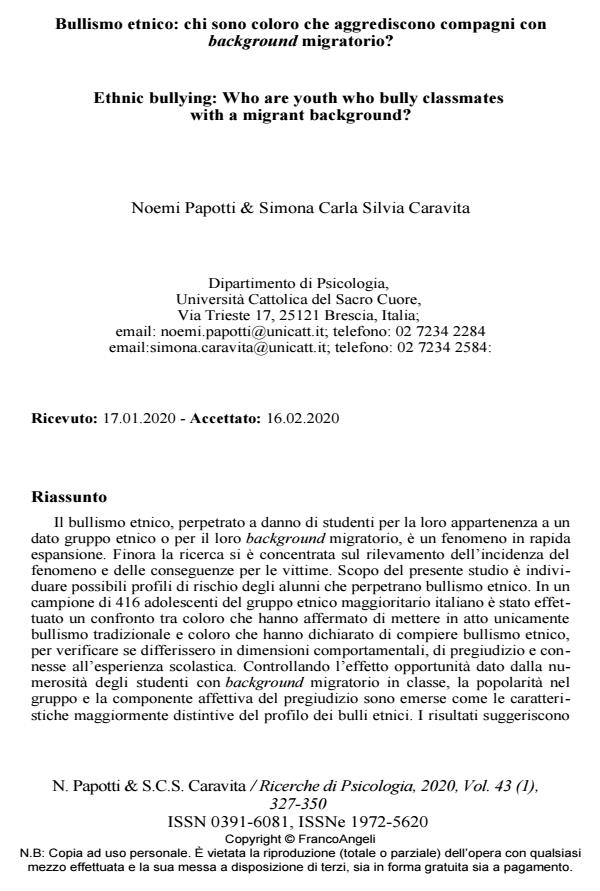Bullismo etnico: chi sono coloro che aggrediscono compagni con background migratorio?
Titolo Rivista RICERCHE DI PSICOLOGIA
Autori/Curatori Noemi Papotti , Simona Carla Silvia Caravita
Anno di pubblicazione 2020 Fascicolo 2020/1
Lingua Italiano Numero pagine 24 P. 327-350 Dimensione file 248 KB
DOI 10.3280/RIP2020-001015
Il DOI è il codice a barre della proprietà intellettuale: per saperne di più
clicca qui
Qui sotto puoi vedere in anteprima la prima pagina di questo articolo.
Se questo articolo ti interessa, lo puoi acquistare (e scaricare in formato pdf) seguendo le facili indicazioni per acquistare il download credit. Acquista Download Credits per scaricare questo Articolo in formato PDF

FrancoAngeli è membro della Publishers International Linking Association, Inc (PILA)associazione indipendente e non profit per facilitare (attraverso i servizi tecnologici implementati da CrossRef.org) l’accesso degli studiosi ai contenuti digitali nelle pubblicazioni professionali e scientifiche
Il bullismo etnico, perpetrato a danno di studenti per la loro appartenenza a un dato gruppo etnico o per il loro background migratorio, e un fenomeno in rapida espansione. Finora la ricerca si e concentrata sul rilevamento dell’incidenza del fenomeno e delle conseguenze per le vittime. Scopo del presente studio e individuare possibili profili di rischio degli alunni che perpetrano bullismo etnico. In un campione di 416 adolescenti del gruppo etnico maggioritario italiano e stato effettuato un confronto tra coloro che hanno affermato di mettere in atto unicamente bullismo tradizionale e coloro che hanno dichiarato di compiere bullismo etnico, per verificare se differissero in dimensioni comportamentali, di pregiudizio e connesse all’esperienza scolastica. Controllando l’effetto opportunita dato dalla numerosita degli studenti con background migratorio in classe, la popolarita nel gruppo e la componente affettiva del pregiudizio sono emerse come le caratteristiche maggiormente distintive del profilo dei bulli etnici. I risultati suggeriscono che i tradizionali programmi anti-bullismo, incentrati principalmente sulle dinamiche di gruppo, non siano sufficienti per prevenire e contrastare il bullismo etnico.
Parole chiave:Bullismo etnico, immigrazione, pregiudizio, relazioni tra pari, competenze sociali.
- The Strengths and Difficulties Questionnaire Dysregulation Profile Teacher-Report: Psychometric Properties and Associations with Aspects of School Experience Valentina Levantini, Marina Camodeca, Carmen Gelati, in Child Psychiatry & Human Development /2024 pp.831
DOI: 10.1007/s10578-022-01441-5 - Negative attitudes towards ethnic minorities and ethnic bullying and discrimination: a systematic review and meta-analysis Maria Chiara Taiti, Benedetta E. Palladino, Maria Grazia Lo Cricchio, Fulvio Tassi, Ersilia Menesini, in European Journal of Developmental Psychology /2024 pp.795
DOI: 10.1080/17405629.2024.2371547 - Migrazioni e psicologie. Introduzione al Forum Alessandro Antonietti, Antonella Marchetti, in RICERCHE DI PSICOLOGIA 1/2020 pp.13
DOI: 10.3280/RIP2020-001002 - Prejudice and Ethnic Bullying Among Children: The Role of Moral Disengagement and Student-Teacher Relationship Nicolò Maria Iannello, Marina Camodeca, Carmen Gelati, Noemi Papotti, in Frontiers in Psychology 713081/2021
DOI: 10.3389/fpsyg.2021.713081 - Prestige norms of moral disengagement, prejudice, and ethnic bullying: a study among Italian early adolescents Noemi Papotti, Simona C. S. Caravita, in European Journal of Developmental Psychology /2024 pp.627
DOI: 10.1080/17405629.2023.2275824
Noemi Papotti , Simona Carla Silvia Caravita, Bullismo etnico: chi sono coloro che aggrediscono compagni con background migratorio? in "RICERCHE DI PSICOLOGIA " 1/2020, pp 327-350, DOI: 10.3280/RIP2020-001015